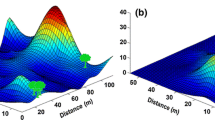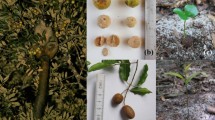Abstract
In Mediterranean semiarid areas, limited water supply confers to woody non-arboreal formations (scrublands) a capital importance. Fleshy fruiting shrubs provide food resources for vertebrates giving rise to well-known mutualisms, poorly studied in marginal Mediterranean areas. We assessed seed dispersal in three shrub species (Rhamnus lycioides spp. lycioides Brot., Asparagus albus L., Pistacia lentiscus L.) considering birds as the main vector and pine trees (Pinus halepensis Miller.) as key structural elements in seed deposition and establishment. The study area is a small forest fragment with an artificially high standing density of pine trees. The initial hypothesis is that birds direct dispersal towards the tree stratum, thus conditioning shrub regeneration. Collector trays, placed under shrubs and pine trees (potential perches), were used to estimate fruit consumption and seed rain. Shrub density and regeneration were assessed through vegetation sampling differentiating three age classes (seedlings, saplings and adults). The highest estimated consumption by birds was recorded on A. albus (76 % of the fruits available). R. lycioides and P. lentiscus were less consumed (47 and 36 %) but achieved a relatively important dispersal towards perches (0.88 % of the total fruit crop, and 1.89 % of the fruits consumed in Rhamnus, and up to 2.94 and 8.18 % in Pistacia, compared to only 0.09 and 0.13 % in Asparagus). More than 80 % of A. albus seedlings grew under the tree canopy, also the microhabitat preferred by A. albus and R. lycioides saplings. Approximately half of the extant adult shrubs were under the tree layer (more than 80 % considering dead trees), although canopy cover was only 13.81 %. Only a small fraction of the seeds was deposited under trees, but their canopy seemed to provide a favourable regeneration niche, at least during the germination and establishment phases. The management of tree density seems thus crucial for fostering the transition of these reforestations towards healthier and more resilient woody formations.



Similar content being viewed by others
References
Altorre F, Francesconi F, Scarnati L, De Sanctis M, Alfó M, Bruno F (2008) Predicting the effect of climate change on tree species abundance and distribution at a regional scale. iForest 1:132–139
Aronne G, Wilcock CC (1994) First evidence of myrmecochory in fleshy-fruited shrubs of the Mediterranean region. New Phytol 127:781–788
Barroso A, Amor F, Cerdá X, Boulay RR (2013) Dispersal of non-myrmecochorous plants by a “keystone disperser” ant in a Mediterranean habitat reveals asymmetric interdependence. Insectes Soc 60:75–86
Bas JM, Gómez C, Pons P (2005) Fruit production and predispersal seed fall and predation in Rhamnus alaternus (Anacardiaceae). Acta Oecol 27:115–123
Bas J, Pons P, Gómez C (2006) Exclusive frugivory and seed dispersal of Rhamnus alaternus in the bird breeding season. Plant Ecol 183:77–89
Blanco P, Navarro RM (2003) Aboveground phytomass models for major species in shrub ecosystems of western Andalusia. Invest Agrar-Sist Rec F 12:47–55
Calef MP, McGuire AD, Epstein HD, Rupp TS, Shugart HH (2005) Analysis of vegetation distribution in Interior Alaska and sensitivity to climate change using a logistic regression approach. J Biogeogr 32:863–878
Cortina J, Amat B, Castillo V, Fuentes D, Maestre FT, Padilla FM, Rojo L (2011) The restoration of vegetation cover in the semi-arid Iberian southeast. J Arid Environ 75:1377–1384
Cousens R, Dytham C, Law R (2008) Dispersal in Plants. A population perspective. Oxford University Press, Oxford
Debussche M, Isenmann P (1994) Bird-dispersed seed rain and seedling establishment in patchy Mediterranean vegetation. Oikos 69:414–426
Di Castri F, Goodall DW, Specht RL (1981) Mediterranean-type shrublands. Ecosyst World 11:1–52
Diaz-Barradas MC, Correia OA (1999) Sexual dimorphism, sex-ratio and spatial distribution of male and female shrubs in the dioecious species Pistacia lentiscus L. Folia Geobot 34:163–174
Esteve-Selma MA, Chaparro J, Pardo MT, Vives R (2003) Los sistemas forestales desde una perspectiva histórica: las repoblaciones forestales. Cap. 6.4., en: Esteve-Selma MA, Lloréns Pascual de Riquelme M, Martínez-Gallur C (Eds.). Los recursos naturales de la región de Murcia. Un análisis interdisciplinar. Universidad de Murcia, Murcia
Esteve-Selma MA, Martínez-Fernández J, Hernández I, Montávez JP, López JJ, Calvo JF, Robledano F (2010) Effects of climatic change on the distribution and conservation of Mediterranean forests: the case of Tetraclinis articulata in the Iberian Peninsula. Biodivers Conserv 19(13):3809–3825
Esteve-Selma MA, Martínez-Fernández J, Hernández-García I, Montávez JP, López-Hernández JJ, Calvo JF (2012) Potential effects of climate change on the distribution of Tetraclinis articulata, an endemic tree from arid Mediterranean ecosystems. Clim Chang. doi:10.1007/s10584-011-0378-0
Garcia D, Zamora R, Amico GC (2010) Birds as suppliers of seed dispersal in temperate ecosystems: conservation guidelines from real-world landscapes. Conserv Biol 24:1070–1079
García D, Obeso JR, Martínez I (2005) Spatial concordance between seed rain and seedling establishment in bird-dispersed trees: does scale matter? J Ecol 93:693–704
Godínez-Álvarez H (2004) Pollination and seed dispersal by lizards: a review. Rev Chil Hist Nat 77:569–577
Graham LLB, Page SE (2012) Artificial bird perches for the regeneration of degraded tropical peat swamp forest: a restoration tool with limited potential. Restor Ecol 20:631–637
Heelemann S, Krug CB, Esler KJ, Reisch C, Poschlod P (2012) Pioneers and perches—promising restoration methods for degraded renosterveld habitats? Restor Ecol 20:18–23
Herrera CM (1982) Defense of ripe fruits from pests: its significance in relation to plant-disperser interactions. Am Nat 120:218–241
Herrera CM (1995) Plant-Vertebrated seed dispersal systems in the Mediterranean: ecological, Evolutionary and historical determinants. Annu Rev Ecol Evol S 26:705–727
Herrera CM (2002) Seed dispersal by vertebrates. In: Herrera CM, Pellmyr O (eds) Plant-animal interactions: an evolutionary approach. Blackwell Scientific Publications, Oxford, UK, pp 185–208
Herrera CM (2004) Ecología de los pájaros frugívoros ibéricos. In: Tellería JL (ed) La ornitología hoy: Homenaje al Profesor Francisco Bernis Madrazo. Editorial Complutense, Universidad Complutense, Madrid, pp 127–153
Howe HF (1989) Scatter-and clump-dispersal and seedling demography: hypothesis and implications. Oecologia 79:417–426
Howe HF, Miriti MN (2004) When Seed Dispersal Matters. Bioscience 54:651–660
Howe HF, Smallwood J (1982) Ecology of seed dispersal. Ann Rev Ecol Syst 13:201–228
Jordano P (1989) Pre-dispersal biology of Pistacea lentiscus (Anacardiaceae): cumulative effects on seed renoval by birds. Oikos 55:375–386
Jordano P, García C, Godoy JA, García-Castaño JL (2008) Differential contribution of frugivores to complex seed dispersal patterns. P Natl Acad Sci USA 104(9):3278–3282
Luzuriaga AL, Sánchez AM, Maestre FT, Escudero A (2012) Assemblage of a semi-arid annual plant community: abiotic and biotic filters act hierarchically. PLoS ONE 7:e41270
Maestre FT, Cortina J (2002) Are Pinus halepensis plantations useful as a restoration tool in semiarid Mediterranean areas? For Ecol Manag 198:308–317
Maestre FT, Cortina J (2005) Remnant shrubs in Mediterranean semi-arid steppes: effects of shrub size, abiotic factors and species identity on understorey richness and occurrence. Acta Oecol 27:161–169
Maestre FT, Cortina J, Bautista S (2004) Mechanisms underlying the interaction between Pinus halepensis and the native late-successional shrub Pistacia lentiscus in a semi-arid plantation. Ecography 27:776–786
Mangas JG, Lozano J, Cabezas-Díaz S, Virgós E (2008) The priority value of scrubland habitats for carnivore conservation in Mediterranean ecosystems. Biodivers Conserv 17:43–51
Mazzoleni S, Porto AL, Blasi C (1992) Multivariate analysis of climatic patterns of the Mediterranean basin. Vegetatio 98:1–12
McClanahan TR, Wolfe RW (1993) Accelerating forest sucesión in a fragmented landscape: the role of birds and perches. Conserv Biol 7:279–288
Nathan R, Muller-Landau HC (2000) Spatial patterns of seed dispersal, their determinants and consequences for recruitment. Trends Ecol Evol 15:278–285
Nathan R, Schurr FM, Spiegel O, Steinitz O, Trakthtenbrot A, Tsoar A (2008) Mechanism of long-distance seed dispersal. Trends Ecol Evol 23:638–647
Navarro RM, Blanco P (2006) Estimation of above-ground biomass in shrublands ecosystems of southern Spain. Invest Agrar-Sist Rec For 15(2):197–207
Navarro T, Pascual V, Alados CL, Cabezudo B (2009) Growth forms, dispersal strategies and taxonomic spectrum in a semi-arid shrubland in SE Spain. J Arid Environ 73:103–112
Pausas JG, Bonet A, Maestre FT, Climent A (2006) The role of the perch effect on the nucleation process in Mediterranean semi-arid oldfields. Acta Oecol 29:346–352
Peñuelas J, Sabaté S, Filella I, Gracia C (2004) Efectos del cambio climático sobre los ecosistemas terrestres: observación, experimentación y simulación. Capítulo 15. In: Valladares F (ed) Ecología del bosque mediterráneo en un mundo cambiante. Ministerio de Medio Ambiente, Madrid, p 425–460
Pugnaire FI, Armas C, Maestre FT (2011) Positive plant interactions in the Iberian Southeast: mechanisms, environmental gradients, and ecosystem function. J Arid Environ 75:1310–1320
Ramos V (2011) Dispersión de frutos de arbustos por las aves en ambientes mediterráneos semiáridos: implicaciones para la conservación de paisajes forestales fragmentados. Trabajo Fin de Máster. Universidad de Murcia, Murcia
R Development Core Team (2009) R: A Language and Environment for Statistical Computing. R Foundation for Statistical Computing, Vienna, Austria, URL: http://www.R-project.org (accessed on 01.09.2013).
Reid JL, Holl KD (2012) Arrival ≠ Survival. Restoration Ecology. Opinion Article. DOI: 10.1111/j.1526-100X.2012.00922.x
Rodríguez-Pérez J, Traveset A (2007) A multi-scale approach in the study of plant regeneration: finding bottlenecks is not enough. Perspec Plant Ecol S9:1–13
Rodríguez-Pérez J, Riera N, Traveset A (2005) Effect of seed pasaje through birds and lizards on emergence rate of mediterranean species: differences between natural and controlled conditions. Funct Ecol 19:667–706
Schupp EW (1993) Quantity, quality and effectiveness of seed dispersal by animals. Vegetario 107(108):15–29
Schupp EW, Jordano P, Gómez JM (2010) Seed dispersal effectiveness revisited: a conceptual review. New Phytol 188:333–335
Sorensen AE (1981) Interactions between birds and fruit in a temperate woodland. Oecologia 50:242–249
Tellería JL, Ramírez A, Pérez-Tris A (2005) Conservation of seed-dispersing migrant birds in Mediterranean habitats: shedding light on patterns to preserve processes. Biol Conserv 124:493–502
Thuiller W (2004) Patterns and uncertainties of species´ range shifts under climate change. Global Change Biol 10:2020–2027
Traveset A (1995) Seed dispersal of Cneorum tricoccon L. (Cneoraceae) by lizards and mammals in the Balearic islands. Acta Oecol 16(2):171–178
Valladares F (2007) El hábitat mediterráneo continental: un sistema humanizado, cambiante y vulnerable. In: Paracuellos M (ed) Ambientes mediterráneos: funcionamiento, biodiversidad y conservación de los ecosistemas mediterráneos. Colección Medio Ambiente, 2. Instituto de Estudios Almerienses, Almería, p 219–238
Verdu M, Garcia-Fayos P (1996) Nucleation processes in a Mediterranean bird-dispersed plant. Funct Ecol 10:275–280
Villers-Ruiz L, Trejo-Vázquez I (1998) Impacto del Cambio Climático en los bosques y áreas naturales protegidas de México. Interciencia 23(1):10–19
Wenny DG (2001) Advantages of seed dispersal: a re-evaluation of directed dispersal. Evol Ecol Res 3:51–74
Wheng ES, Zhou GS (2006) Modeling distribution changes of vegetation in China under future climate change. Environ Model Assess 11:45–58
Zanini L, Ganade G (2005) Restoration of Araucaria forest: the role of perches, pioneer vegetation, and soil fertility. Restor Ecol 13:507–514
Zapata VM, Robledano F (2014) Assessing biodiversity and conservation value of forest patches secondarily fragmented by urbanisation in semiarid southeastern Spain. J Nat Conserv. doi:10.1016/j.jnc.2013.11.002
Acknowledgments
We are grateful to the staff of the Municipality of Murcia’s Environment Services, and especially to Francisco Carpe for allowing us to work in the study area. Several students and graduates of the University of Murcia helped with fieldwork. The comments of an anonymous reviewer considerably improved the structure and contents of the first version of the manuscript.
Author information
Authors and Affiliations
Corresponding author
Additional information
Communicated by N. J. Enright.
Rights and permissions
About this article
Cite this article
Zapata, V.M., Robledano, F., Ramos, V. et al. Bird-mediated seed dispersal of fleshy fruits of mediterranean shrubs in semiarid forest patches: the role of Pinus halepensis Miller trees as seed receptors. Plant Ecol 215, 1337–1350 (2014). https://doi.org/10.1007/s11258-014-0391-2
Received:
Accepted:
Published:
Issue Date:
DOI: https://doi.org/10.1007/s11258-014-0391-2




